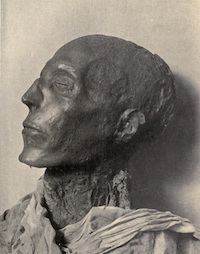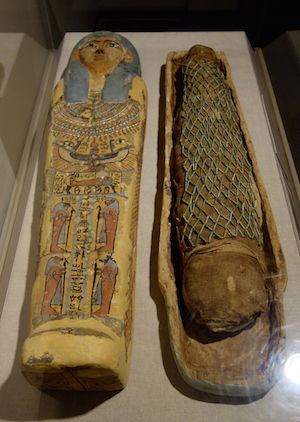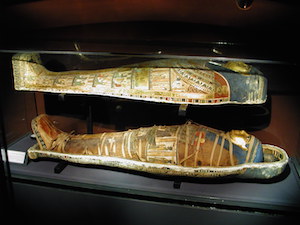First Intermediate Period
Virtually no Hyksos mummies have been found, and those that have been uncovered have suffered water damage, so it is difficult to say with any certainty whether they fully adopted Egyptian practices and beliefs. The mummies we do have from the Second Intermediate Period are from Thebes.
Theban mummies from this period show that the removal of the brain was now much more common. While woman tended to be positioned with their hands at their sides, men often had their hands placed to cover their genitalia.
New Kingdom Mummification
We have a wealth of information regarding the mummies of the New Kingdom, and numerous examples from royal and non-royal burials. Unsurprisingly, royal burials involved the use of the costliest materials, and the most elaborate rituals. Although sometimes the generous application of resins and oil could actually cause the mummy to deteriorate faster. Royal mummies also adopted a new position, with arms crossed across the chest.
Non-royal burials continued to employ a variety of methods, depending on the wealth of the individual. Of course, poorer burials could not extend to these niceties. Although the workers of Deir el Medina often had impressive coffins, their bodies were not treated with resin or oil, just wrapped in linen and interred.

As the New Kingdom progressed, embalmers increasingly tried to make the mummy look more lifelike. From the Nineteenth Dynasty, lichen, sawdust, and linen were all employed to stuff the body so that it did not look so emaciated. The nose of Ramesses II was filled with seeds and bolstered with an animal bone to help it keep its distinctive shape. It became common to place a scrap of linen with a depiction of a living eye over the eye sockets. Strangely, in the mummy of Ramesses IV small onions were placed under his eyelids to mimic the shape of eyeballs.
During the New Kingdom, the brain of the deceased was usually removed by breaking the ethmoid bone in the nose and scraping it out. However, King Ahmose instead had his head partially removed and his brain scooped out via the hole in the base of the skull though which the spinal cord passes!
Rich burials involved large quantities of oils and resins, which sometimes had the unintended consequence of causing the mummy to degrade faster. The quality of the linen bandages also varied depending on the wealth of the deceased. Once the whole body had been wrapped, it was covered in a shroud held in place by horizontal bands of linen. The shroud was generally undecorated, but in some cases from Deir el Medina the deceased is depicted in front of an offering table.
Third Intermediate Period
During the Third Intermediate Period Egyptian embalmers perfected the art of mummification. Several cuts (described in detail in the Rhind Medical Papyrus) were made to the body so that it could be packed with mud, sawdust and resin to return it to a lifelike shape. The viscera were no longer placed in canopic jars, but wrapped and treated and returned to the body. Despite this, canopic jars remained popular in burials, although sometimes they were solid dummies.

There are examples where a sick or elderly person has been made whole again by the embalmer (for example a lady with bed sores had these repaired by the application of gazelle skin). Of course, that too could cause problems. If the body was packed too full, the skin could split!
Once the body was the desired shape, the skin was painted (red for men, and yellow for women as in Egyptian paintings) and cosmetics added to define the eyes, eyebrows, and lips. Glass or stone eyes were often placed in the eye sockets. Then the body was wrapped in linen bandages using a figure of eight method which gave the body better stability, and covered with a shroud (sometimes decorated with an image of Osiris).
After the Twenty-First dynasty there is a marked decline in the quality of mummification. The body was still packed to resemble a lifelike shape, but viscera were wrapped and placed on the thighs of the mummy not in the body, and the skin was no longer painted and repaired.
Late Period

By the Late Period, the brain was generally left in the head, and evisceration was sometimes conducted via a cut to the right side of the body rather than the left. There are examples where the embalmers tried to eviscerate the body without using turpentine or other solvents, causing quite a bit of damage to the body. There are also examples of non-royal mummies having their hands placed across their chest (copying royal mummies).
Towards the end of the period even evisceration was being abandoned. Many bodies were quickly dried and covered with resin or bitumen before being wrapped – often rather poorly. Only a few examples of proper mummification date to this late period.
Graeco-Roman Period

If the viscera were removed from the body at all during the Graeco-Roman Period, they were usually placed on the thighs – although empty canopic jars were also included in some burials. There are a few examples of embalmers restoring damaged bodies and preparing them in the traditional manner, but the quality of mummification varied greatly. However, the quality of linen wrappings did improve, and the shroud was often decorated with detailed images of Isis and Nepythys, or scenes from one of the funerary texts.
During the Roman Period, distinctive rhomboid coffers held in place by golden or gilded studs were wrapped around the body. Multi-coloured bandages were sometimes used to decorate the mummy, and wooden portrait panels were held in place with linen wrappings.
During the fourth century a new method was developed – immersing the body in honey. The body of Alexander the Great was apparently treated this way, but as it has not been found we cannot confirm this.
Christian and Coptic bodies were rarely mummified, but seem to have been cured using salt and sometimes natron. One unusual example from the Coptic Period resembles an earlier mummy except for the black cross painted on the throat of the mummy. It seems that the Christians did not approve of pagan mummification rituals – but they did continue to embalm saints and other important religious figures.
The Evolution of Mummification; part one
Bibliography
- Bard, Kathryn (2008) An introduction to the Archaeology of Ancient Egypt
- Grajetzki, W (2003) Burial Customs in Ancient Egypt
- Ikram, Salima (1997) Death and Burial in Ancient Egypt
- Ikram, Salima and Dodson, Aidan (1998) The Mummy in Ancient Egypt
- Kemp, Barry J (1991) Ancient Egypt: Anatomy of a Civilisation
Copyright J Hill 2016